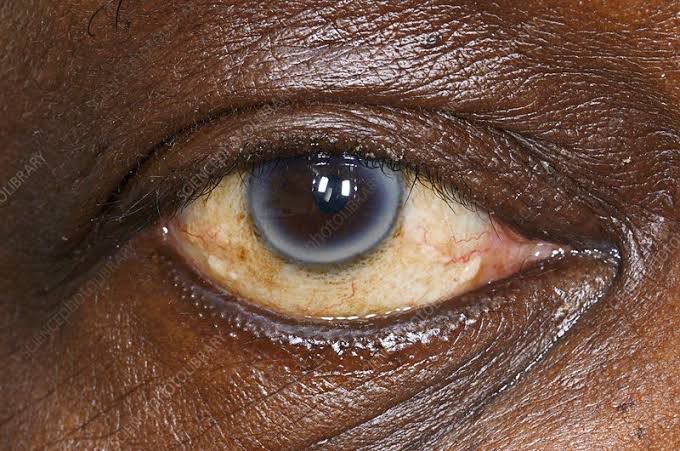
Arcus senilis is a white, gray, or blue arc or ring that develops around the edge of the cornea. It typically appears as an arc that affects the top and bottom of the cornea. Over time, the arcs can grow and connect, forming a complete ring. It is common among people who are in their 60s and older. The whitish arc is caused by the deposit of fat (lipids) around the cornea. It is associated with hypercholesterolemia (elevated cholesterol), high alcohol intake, and smoking.
Arcus senilis is harmless. However, if the ring appears in young adults, it may sometimes be a sign of high cholesterol. The rings are made up of fatty deposits called lipids. Arcus senilis is also known as corneal arcus. If the rings appear in young adults and children, it is referred to as arcus juvenilis.
Although the appearance of arcus senilis may be concerning, they do not affect a person’s vision and are not a sign of a serious medical condition. However, contacting a doctor will ensure that there are no hidden causes that could lead to further health complications if treatment is required.
CAUSES AND RISK FACTORS FOR ARCUS SENILIS
Arcus senilis most commonly appears as people age. The American Association of Ophthalmology states that nearly all people will eventually develop the condition, and that it appears to be more common in men. Also, some studies suggest that it is more common in people of African and Asian descent.
IS ARCUS SENILIS A SIGN OF HIGH CHOLESTEROL?
Studies show that there is a link between the condition and high cholesterol, which can lead to cardiovascular problems. Arcus senilis occurs due to fat deposits, or lipids, forming in the outer part of the cornea. Fats in the blood come from fatty foods in a person’s diet. The liver also produces them. Cholesterol is one type of fat that appears in the blood.
As someone ages, their blood vessels widen and allow more cholesterol and other fats to build up in the eye. If arcus senilis appears in people under the age of 40, your doctor may order tests to check for high cholesterol. The occurrence of arcus senilis does not entirely mean that someone has high cholesterol. High cholesterol could be due to diet, lifestyle, or genetic conditions.
POSSIBLE COMPLICATIONS:
Arcus senilis does not have any complications unless it is a sign of high cholesterol.
High levels of cholesterol in a person’s blood can cause significant problems, such as coronary artery disease or cardiovascular disease. Arcus senilis is not a vision problem. However, it could indicate other health conditions.
SYMPTOMS OF ARCUS SENILIS:
A person with arcus senilis may notice a white, gray, or blue circle or arc around the cornea of the eye.
People with arcus senilis are unlikely to have any other symptoms, and their vision will remain unaffected.
DIAGNOSING ARCUS SENILIS:
To diagnose arcus senilis, a doctor will perform an eye examination. The eye doctor will examine the front of the eye with a slit-lamp Biomicroscope. If the ring is present only in one eye (unilateral arcus senilis), it may indicate a problem with the carotid artery and heart disease.
The examination may also involve placing special eye drops into the person’s eye that widen the pupil. These drops allow the doctor to inspect the blood vessels at the back of the eye for signs of disease.
The doctor will check the thickness of the vessels for increased levels of fat deposits. They will also look for signs of artherosclerosis, which is a condition where arteries become clogged with fatty substances. If a doctor suspects both arcus senilis and atherosclerosis, they will usually refer people to their primary care doctor or a cardiologist.
A blood test will determine whether someone has high cholesterol. If they do, a doctor may prescribe medication or advise on a suitable diet and exercise program to lower the cholesterol in their blood.
TREATMENT OF ARCUS SENILIS:
Once it appears, it will not fade or disappear. However, treatment for arcus senilis is not necessary.
If arcus senilis is a sign of high cholesterol, a doctor may recommend a diet that is low in saturated fats and high in fruit, vegetables, and fiber. Increased exercise and quitting smoking can also help.
SUMMARY:
Arcus senilis is a common condition that develops as people age.
It occurs when deposits of fat surround the cornea of the eye. Older adults are more prone to arcus senilis because blood vessels in the eye open with age, allowing more cholesterol to enter.
If it develops in those under the age of 40, a doctor may recommend a blood test to check cholesterol levels. The coloring in the eye itself does not cause vision problems. However, once observed visit your eye doctor for proper diagnosis and counseling.
